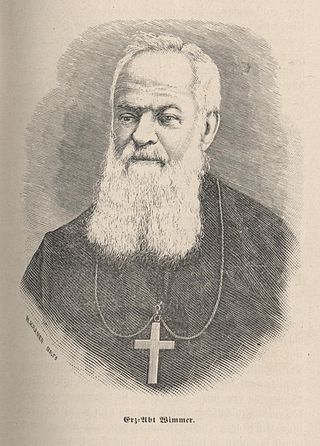
The Benedictines, officially the Order of Saint Benedict, are a mainly contemplative monastic order of the Catholic Church for men and for women who follow the Rule of Saint Benedict. Initiated in 529 they are the oldest of all the religious orders in the Latin Church. The male religious are also sometimes called the Black Monks, especially in English speaking countries, after the colour of their habits. Not all Benedictines wear black, however, with some like the Olivetans wearing white. They were founded by Benedict of Nursia, a 6th-century Italian monk who laid the foundations of Benedictine monasticism through the formulation of his Rule. Benedict's sister, Scholastica, possibly his twin, also became a religious from an early age, but chose to live as a hermit. They retained a close relationship until her death.

The Benedictine Confederation of the Order of Saint Benedict is the international governing body of the Order of Saint Benedict.

Gerard van Caloen (1853–1932) was a Belgian Benedictine liturgist, missionary, monastic founder, abbot, and bishop. He was rector of the abbey school at Maredsous, where in 1882 he published the Missel des Fidèles, the first French-Latin missal. He also introduced British-style association football to the school. In 1886, he was professor of liturgy at the College of Sant'Anselmo in Rome.
The Abbot Primate of the Order of St. Benedict serves as the elected representative of the Benedictine Confederation of monasteries in the Catholic Church. While normally possessing no authority over individual autonomous monasteries or congregations, he does serve as a liaison to the Vatican on behalf of the Benedictines, promotes unity among Benedictine monasteries and congregations, and represents Benedictines at religious gatherings throughout the world. He resides in Rome, Italy, at the Abbey of Sant'Anselmo all'Aventino which serves, because he is Abbot Primate, as the "Primatial Abbey of Sant'Anselmo." He appoints a Rector to oversee the College of Sant'Anselmo, serves as the "Grand Chancellor" of the Pontificio Ateneo Sant'Anselmo, and appoints a Rector to oversee the Church of Sant'Anselmo.

The American-Cassinese Congregation is a Catholic association of Benedictine monasteries founded in 1855. The monasteries of the congregation follow the monastic way of life as outlined by St. Benedict of Nursia in his early 6th century Rule of Saint Benedict. The congregation is one of 19 congregations in the Benedictine Confederation and includes 25 monasteries: 19 autonomous abbeys and 6 dependent priories, located across 15 states and Puerto Rico, as well as Brazil, Canada, Colombia, Mexico, and Taiwan.

Saint Anselm Abbey, located in Goffstown, New Hampshire, United States, is a Benedictine abbey composed of men living under the Rule of Saint Benedict within the Catholic Church. The abbey was founded in 1889 under the patronage of Saint Anselm of Canterbury, a Benedictine monk of Bec and former archbishop of Canterbury in England. The monks are involved in the operation of Saint Anselm College. The abbey is a member of the American-Cassinese Congregation of the Benedictine Confederation.
The Subiaco Cassinese Congregation is an international union of Benedictine houses within the Benedictine Confederation. It developed from the Subiaco Congregation, which was formed in 1867 through the initiative of Dom Pietro Casaretto, O.S.B., as a reform of the way of life of monasteries of the Cassinese Congregation, formed in 1408, toward a stricter contemplative observance, and received final approval in 1872 by Pope Pius IX. After discussions between the two congregations at the start of the 21st century, approval was given by Pope Benedict XVI in 2013 for the incorporation of the Cassinese Congregation into its offshoot, the Subiaco Congregation. The expanded congregation was given this new name.

The Abbey of Saint Scholastica, also known as Subiaco Abbey, is located just outside the town of Subiaco in the Province of Rome, Region of Lazio, Italy; and is still an active Benedictine abbey, territorial abbey, first founded in the 6th century AD by Saint Benedict of Nursia. It was in one of the Subiaco caves that Benedict made his first hermitage. The monastery today gives its name to the Subiaco Congregation, a grouping of monasteries worldwide that makes up part of the Order of Saint Benedict.
St. Andrew's Abbey, Bruges was a Benedictine abbey in Sint-Andries, Bruges, Belgium, which was destroyed in the French Revolution. Its modern successor St. Andrew's Abbey, Zevenkerken, founded in 1899–1900, is a Benedictine abbey of the Congregation of the Annunciation.

Andreas Amrhein was a Swiss Benedictine monk who founded the Benedictine Congregation of Saint Ottilien and the Missionary Benedictine Sisters of Tutzing to combine the Benedictine way of life with activity in the mission field.

The Swiss-American Congregation is an association of Benedictine monasteries founded in 1881 in the United States, as a part of the international Benedictine Confederation of monasteries.
St Benedict's Abbey, Pietersburg (Polokwane), Limpopo, South Africa, is a Benedictine monastery of the Subiaco Congregation. It began in 1911 as a mission territory; the community established a monastery in 1937. As an Abbey Nullius, the monastery governed what is now the Roman Catholic Diocese of Polokwane until 1989. As of 2022, the community numbers about 12 in various stages of formation monks. The community was given the Very Rev. Dominic Mohapi, OSB, as Prior Administrator on August 18, 2022. On October 1, 2023, the Very Rev. Ghislain Maluvu, OSB, was appointed as Prior Administrator.
Abbaye de l'Ascension, Dzogbégan, Plateaux Region, Togo, is a Benedictine monastery of the Subiaco Cassinese Benedictine Congregation. Founded by French monks in 1961, the monastery was elevated to abbatial status in 1991. As of 2022, the monastery was home to thirty monks, under the leadership of Abbot Fr Theodore Kouassis Coco who is the second abbot of the monastic community.

The Congregation of the Annunciation, formerly known as the Belgian Congregation, is a congregation of monasteries within the Roman Catholic Benedictine Confederation. Founded in 1920, the Congregation includes fifteen independent male monasteries spread throughout ten countries. Additionally, two female monasteries are members of the Congregation, while a further ten are affiliated with the Congregation.

The Abbey of Our Lady of Montserrat, or Manila Abbey, is a Benedictine men's monastery located on Mendiola Street in Manila, the Philippines. The monastery was founded by monks from Spain in 1895, in the final years of Spanish colonial era in the Philippines and is dedicated to Our Lady of Montserrat.

St Augustine's Abbey or Chilworth Abbey, formerly Chilworth Friary, is a Roman Catholic Benedictine abbey in Chilworth, Surrey. The building, which is Grade II listed, was designed by Frederick Walters and was built in 1892. It was formerly a Franciscan friary and a novitiate for the order. The abbey church is open to the public 365 days a year.

Pietro Casaretto, O.S.B. (1810-1878) was an Italian Benedictine monk who established the Subiaco Congregation, an international federation of Benedictine monasteries, now part of the Subiaco Cassinese Congregation.

The Abbey of Our Lady of Montserrat, more commonly known as the Mosteiro de São Bento (Monastery of St. Benedict), is a Benedictine abbey located on the Morro de São Bento in downtown Rio de Janeiro, Brazil. The Mannerist style church is a primary example of Portuguese colonial architecture in Rio and the country.
The Benedictine Priory of Savannah is a Catholic monastery of Benedictine monks located in Savannah, Georgia. The priory was founded in 1877, and is a dependency of Saint Vincent Archabbey in Latrobe, Pennsylvania, and thereby belongs to the American-Cassinese Congregation. It currently operates the Benedictine Military School for boys.
St. Benedict's Abbey is an American community of monks of the Order of St. Benedict located in Atchison, Kansas. It was founded in 1857 to provide education to the sons of German settlers in the Kansas Territory.













